
SDO NOT cut down a partially fallen tree with your saw. Be extremely cautious with partially fallen trees that may be poorly supported. When a tree doesn’t fall com- pletely, set the saw aside andpull down the tree with a cable winch, block and tackle, or tractor.
CUTTING A FALLEN TREE
(BUCKING)
Bucking is the term used for cutting a fallen tree to the desired log size.
![]() WARNING: Do not stand on the log being cut. Any portion can roll causing loss of footing and control. Do not stand downhill of the log being cut.
WARNING: Do not stand on the log being cut. Any portion can roll causing loss of footing and control. Do not stand downhill of the log being cut.
IMPORTANT POINTS
SCut only one log at a time.
S Cut shattered wood very carefully; sharp pieces of wood could be flung toward opera- tor.
SUse a sawhorse to cut small logs. Never allow another person to hold the log while cutting and never hold the log with your leg
or foot.
SDo not cut in an area where logs, limbs, and roots are tangled such as in a blown down area. Drag the logs into a clear area before cutting by pulling out exposed and cleared logs first.
TYPES OF CUTTING USED FOR BUCKING
![]() WARNING: If saw becomes pinched or hung in a log, don’t try to force it out. You can lose control of the saw resulting in injury and/or damage to the saw. Stop the saw, drive a wedge of plastic or wood into the cut until the saw can be removed easily. Re- start the saw and carefully reenterthe cut. To avoid kickback and chain damage, do not use a metal wedge. Do not attempt to restart your saw when it is pinched or hung in a log.
WARNING: If saw becomes pinched or hung in a log, don’t try to force it out. You can lose control of the saw resulting in injury and/or damage to the saw. Stop the saw, drive a wedge of plastic or wood into the cut until the saw can be removed easily. Re- start the saw and carefully reenterthe cut. To avoid kickback and chain damage, do not use a metal wedge. Do not attempt to restart your saw when it is pinched or hung in a log.
Use a wedge to remove pinched saw
Turn saw OFF and use a plastic or wooden wedge to force cut open.
Overcutting begins on the top side of the log with the bottom of the saw against the log. When overcutting use light downward pres- sure.
Overcutting
Undercutting
Undercuttinginvolves cutting on the under- side of the log with top of saw against the log. When undercutting use light upward pres-
sure. Hold saw firmly and maintain control. The saw will tend to push back toward you.
![]() WARNING: Never turn saw upside down to undercut. The saw cannot be con- trolled in this position.
WARNING: Never turn saw upside down to undercut. The saw cannot be con- trolled in this position.
Always make your first cut on the compres- sion side of the log. The compression side of the log is where the pressure of the log’s weight is concentrated.
First cut on compression side of log
Second cut
Second cut
First cut on compression side of log
BUCKING WITHOUT A SUPPORT
SOvercut through 1/3 of the diameter of the log.
SRoll the log over and finish with a second overcut.
SWatch for logs with a compression side to prevent the saw from pinching. See il- lustrations for cutting logs with a compres- sion side.
BUCKING USING A LOG OR
SUPPORT STAND
SRemember your first cut is always on the compression side of the log.
(Refer to the illustrations below for your
first and second cut)
S Your first cut should extend 1/3 of the diameter of the log.
SFinish with your second cut.
Using a log for support
2nd Cut
1st Cut
1st Cut
2nd Cut
12
